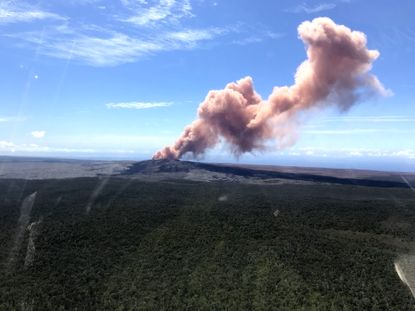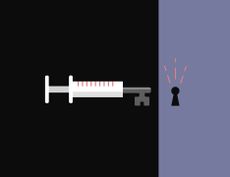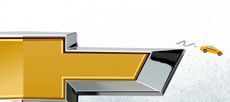How volcanoes work
Kilauea's dramatic eruption has shaken Hawaii's Big Island. Could other U.S. volcanoes blow?

Kilauea's dramatic eruption has shaken Hawaii's Big Island. Could other U.S. volcanoes blow? Here's everything you need to know:
What's happening in Hawaii?
Kilauea, one of the most active volcanoes in the world, is in the midst of the most destructive eruption in its recent history. More than 2,000 people living along the volcano's eastern slope have been forced to flee their homes since early May, when a series of fissures belching lava and noxious gases began opening in the earth. Lava flows have destroyed more than 600 buildings so far, boiled away Hawaii's largest freshwater lake, and filled in Kapoho Bay. Toxic clouds of lava haze, or "laze" — a combination of steam, hydrochloric acid, and microscopic fragments of volcanic glass — have formed where lava is pouring into the ocean. Plumes of ash have risen more than 30,000 feet in the air. There have been no deaths so far, and one serious injury. Depending on how much magma (underground lava) has accumulated beneath Kilauea's surface, the eruption "could last days, weeks, years," said U.S. National Oceanic and Atmospheric Administration volcanologist Bill Chadwick. "We really can't peer through the ground and see it exactly in all its details and intricacies."
Subscribe to The Week
Escape your echo chamber. Get the facts behind the news, plus analysis from multiple perspectives.

Sign up for The Week's Free Newsletters
From our morning news briefing to a weekly Good News Newsletter, get the best of The Week delivered directly to your inbox.
From our morning news briefing to a weekly Good News Newsletter, get the best of The Week delivered directly to your inbox.
Why is Kilauea erupting now?
The volcano has been steadily oozing lava since 1983, and erupting off and on since it was born between 300,000 and 600,000 years ago. It's the youngest of the five volcanoes that created the Big Island through successive lava flows. All the Hawaiian Islands, in fact, are peaks of undersea mountains located over a "hot spot" in the Earth's partially molten mantle. As the Pacific tectonic plate slowly slides over the hot spot, magma flows through cracks to the surface and new volcanoes are formed, creating a chain of islands. Iceland and the Galápagos Islands were also formed this way. The internal plumbing of volcanoes isn't well understood. But the current eruptions were probably caused by a new injection of magma from deep in the mantle, causing pressure to build inside and around Kilauea until the system burst like a pipe.
What other volcanoes are active?
There are 169 potentially active volcanoes in the U.S., according the United States Geological Survey. The USGS defines as "potentially active" those that have erupted within the last 10,000 years. Outside of Hawaii, almost all of these volcanoes are scattered throughout the American West and Alaska as part of the "Ring of Fire," a string of volcanoes circling the Pacific Ocean along the boundary of the Pacific plate.
Are they dangerous?
Potentially. About 50 volcanoes located in six states — Hawaii, Alaska, California, Oregon, Washington, and Wyoming — are rated high priority or highest priority by the USGS for monitoring for possible eruptions. They include Mount Rainier and Mount St. Helens in Washington, Mount Hood in Oregon, and Lassen Peak and Mount Shasta in California. Mount St. Helens is considered the most likely volcano in the 48 contiguous states to erupt again. Fifty-seven people were killed during its last explosive eruption, in 1980. Many of these volcanoes could become far more dangerous than Kilauea.
Why is that?
They're more explosive. Oceanic plates are denser than continental plates, and create less gaseous magma when they melt. The result is the kind of red, runny lava that Hawaiian volcanoes are famous for. Although Kilauea can explode if enough pressure builds up underneath the surface — for example, from molten rock turning groundwater to steam — most of the time lava just seeps out in what's known as an effusive eruption. These relatively gentle flows give the volcano the convex shape of a warrior's shield sitting on the ground, which is why they're called shield volcanoes. In the Ring of Fire, continental plates rich in silica create a stickier, slower moving magma that degasses explosively when it escapes, creating stratovolcanoes with tall, steep sides of hardened ash and volcanic rock. Mount St. Helens was one such volcano; when it erupted, so much energy was released that it blew off the top 1,300 feet of the mountain.
Can scientists predict eruptions?
With the right tools, researchers can forecast the likelihood of an impending eruption — but only several days to several weeks before it happens. They do this by measuring seismic activity created by magma moving up through the Earth, as well as by checking for temperature changes and the presence of volcanic gases. Only half of the country's active volcanoes are equipped with in-ground tools to measure for changes. Spurred by the eruptions in Hawaii, the U.S. Senate recently passed a bill that would authorize $55 million over the next five years to create a "volcano watch office" that would provide round-the-clock monitoring of the nation's active volcanoes, although the measure still has to pass the House. But even the best monitoring won't reveal all of a volcano's secrets. Mount Rainier has been dormant since it last erupted 1,100 years ago, but is under constant surveillance due to its proximity to Seattle and Tacoma. "You can have a volcano that's super well-monitored, but if nothing's happening, you're not getting the opportunity to understand how it works," said Natalia Deligne, a volcano hazard and risk modeler in New Zealand. "It's always the quiet ones, you know?"
How volcanoes kill
Of the more than 278,000 people who have died in volcanic eruptions since 1500, fewer than 1,000 were killed by flowing lava. The biggest danger is from pyroclastic flows — clouds of hot gas, ash, rocks, and other volcanic material that rush from the summit at speeds of more than 50 miles per hour. Temperatures inside this cloud can reach 1,300 degrees. It was a pyroclastic flow that killed an estimated 16,000 people after the eruption of Mount Vesuvius in A.D. 79, burying the Roman cities of Pompeii and Herculaneum. More than 110 people were killed and some 200 still missing after a pyroclastic flow buried a village following an eruption in Guatemala several weeks ago. Tsunamis triggered by eruptions are the second-biggest cause of volcano-related deaths. "Hawaiian volcanoes can be extremely deadly," says geophysicist Mika McKinnon. "But it's a hazard you can walk away from."
Sign up for Today's Best Articles in your inbox
A free daily email with the biggest news stories of the day – and the best features from TheWeek.com
-
 Today's political cartoons - November 16, 2024
Today's political cartoons - November 16, 2024Cartoons Saturday's cartoons - tears of the trade, monkeyshines, and more
By The Week US Published
-
 5 wild card cartoons about Trump's cabinet picks
5 wild card cartoons about Trump's cabinet picksCartoons Artists take on square pegs, very fine people, and more
By The Week US Published
-
 How will Elon Musk's alliance with Donald Trump pan out?
How will Elon Musk's alliance with Donald Trump pan out?The Explainer The billionaire's alliance with Donald Trump is causing concern across liberal America
By The Week UK Published
-
 Are zoos ethical?
Are zoos ethical?The Explainer Examining the pros and cons of supporting these controversial institutions
By Justin Klawans Published
-
 Will COVID-19 wind up saving lives?
Will COVID-19 wind up saving lives?The Explainer By spurring vaccine development, the pandemic is one crisis that hasn’t gone to waste
By Noah Millman Last updated
-
 Coronavirus vaccine guide: Everything you need to know so far
Coronavirus vaccine guide: Everything you need to know so farThe Explainer Effectiveness, doses, variants, and methods — explained
By Jeva Lange Last updated
-
 The climate refugees are here. They're Americans.
The climate refugees are here. They're Americans.The Explainer Wildfires are forcing people from their homes in droves. Where will they go now?
By Joel Mathis Published
-
 Coronavirus' looming psychological crisis
Coronavirus' looming psychological crisisThe Explainer On the coming epidemic of despair
By David Faris Published
-
 The growing crisis in cosmology
The growing crisis in cosmologyThe Explainer Unexplained discrepancies are appearing in measurements of how rapidly the universe is expanding
By Matthew Francis Last updated
-
 What if the car of the future isn't a car at all?
What if the car of the future isn't a car at all?The Explainer The many problems with GM's Cruise autonomous vehicle announcement
By Navneet Alang Published
-
 The threat of killer asteroids
The threat of killer asteroidsThe Explainer Everything you need to know about asteroids hitting Earth and wiping out humanity
By The Week Staff Published